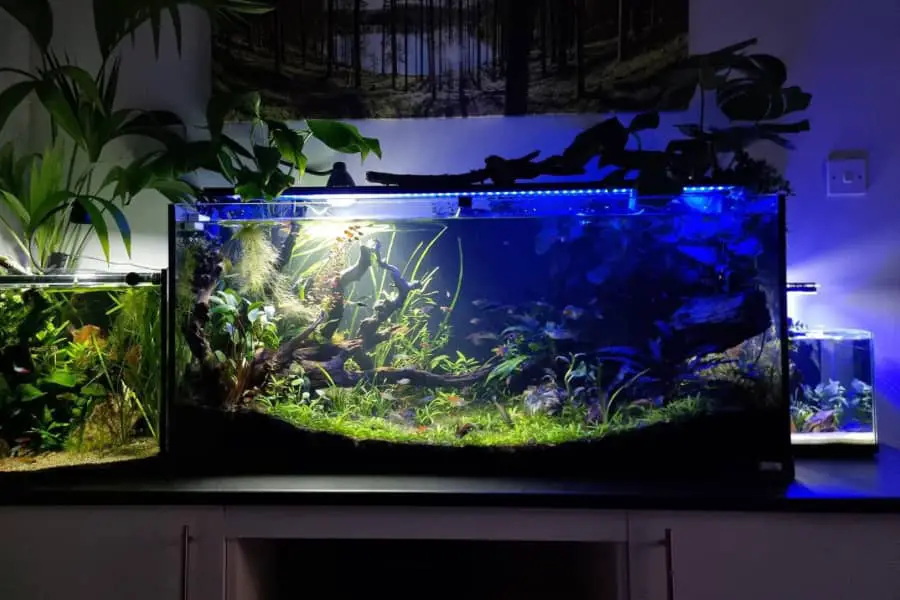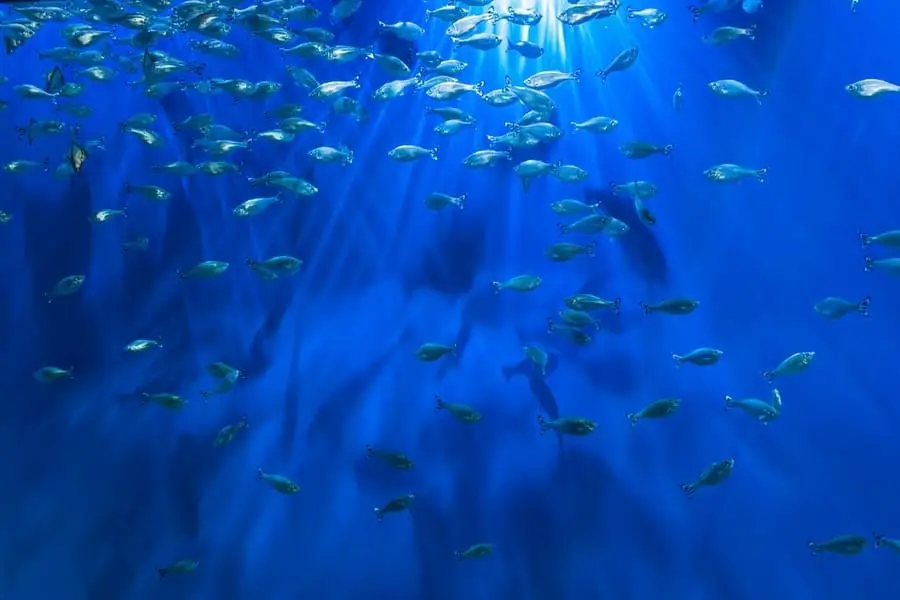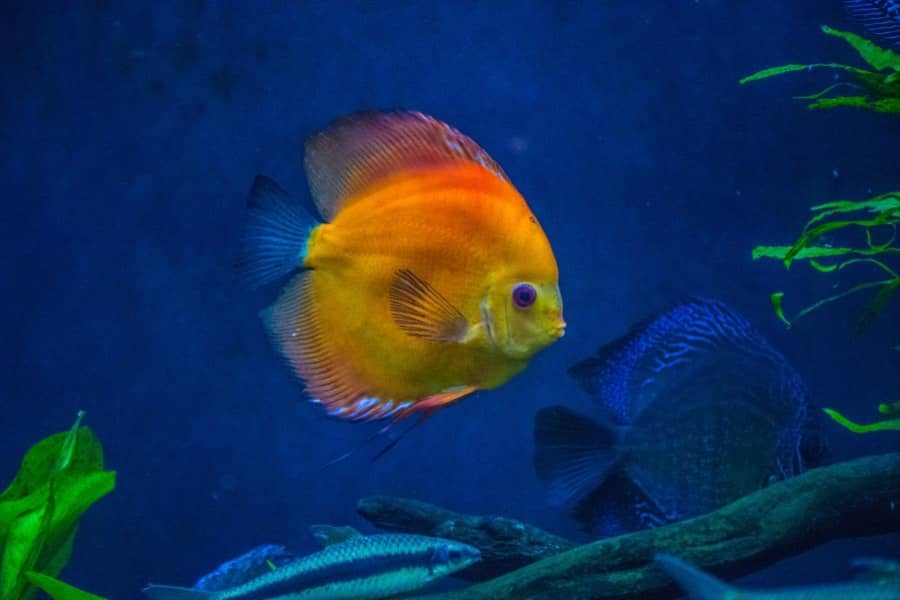Is Blue Light Harmful To Fish?
This post may contain affiliate links.
As an aquarist, you probably want to know if the lighting you’re using is harmful to your fish in any way. Blue light is frequently used in aquariums to mark the days and nights out for the fish or for fishkeepers to get a clear view of their tank.
In this article, we will discuss whether blue light is bad for fish eyesight and why we use blue light in aquariums. We will also look at which types of fish are nocturnal, when you should turn your lighting off, and the effect lighting has on planted tanks and algae.
Is Blue Light Bad For Fish?

Blue light can be harmful to fish if it used too long or with too high intensity. Actually, blue light have shorter wavelengths than other colors of light, can reach deeper into the water, and can damage fish retina.
In a study, goldfish were exposed to 450 nm blue light with intensity of 0.5, 1.0, and 1.5 W/m2 for 4 weeks, and researchers found that blue light had bad effects on fish retina, leading to decreased eyesight.
However, most fish keepers use blue lighting in their tanks with no ill effects. Remember to use aquarium-safe products only, and give your fish 12 hours with the lighting on and 12 hours with it off, every day.
Can Blue Light Harm My Fish?
Blue light can affect fish reproductive cycles and damage their eyesight, but most fishkeepers have no blue light issues. Blue light is essential if you have live plants in your tank as without it, they will be unable to photosynthesize. However, too much light will fuel algal growth, which is hard to get rid of.
Is Blue Light Bad for Fish Eyesight?
Some studies have found that blue light causes more stress to fish retinas. Researchers have also found that even low-intensity blue light can cause cell death in goldfish retinas.
However, these cases are rare, and there is little evidence to suggest that blue lighting is harmful to your fish.
How Does Blue Light Affect Fish Reproductive Cycles?

Like guppies and rotan, some types of fish develop better from fry to adult under blue light. Other species of fish prefer green light, and most don’t grow as well under red light. However, red light is useful for plants and accentuates anything red in your tank, like fish or plants.
Blue light on its own is not likely to affect fish reproductive rates or the development of juveniles, and it may even boost growth. However, incorrectly used lighting can suppress fish reproductive hormones and hurt reproduction and growth.
When Should I Turn the Tank Lighting Off?
You shouldn’t leave your tank lights on for more than 12 hours at a time. Your fish have day and night cycles, just like you, and if they don’t have dependable light cycles to manage their daily lives, they will get stressed, and their immune systems will weaken.
Find out if your fish are diurnal (awake in the daytime) or nocturnal (awake at night), and set your lighting accordingly.
Leaving your aquarium lights on for too long will also cause algae to grow uncontrollably. You should never set your fish tank up by a window for the same reason.
Green Aqua has a fantastic lighting video tutorial here:
Which Types of Fish Are Nocturnal?
Nocturnal fish live their lives at night and sleep during the day. Several types of fish plan their breeding or feeding by the phases of the moon, and others favor different parts of the ocean or lake at night. Many species of fish are nocturnal, including:
- Cardinalfish
- Squirrelfish
- Snappers
- Moray eels
- Octopus
- Many invertebrates
Does Too Much Lighting Cause Algae to Grow?
Two crucial things cause algae to grow:
- Lighting: Algae are autotrophs, which means they photosynthesize their food from light. The more light you give them, the quicker they’ll grow.
- Nutrients: The more nutrients that are in your tank water, like nitrogen and phosphorus, the more fuel algae has to grow and reproduce.
Powerful electric lights are the perfect feeding ground for algae, so you’ll need to limit the time your tank lighting is left on.
Read also:
Why Do Plants Need Blue Light?
Plants need blue and red light to remain healthy. Most plants use blue light to produce chlorophyll, the green pigments found in plant cells. Chlorophyll is fundamental to photosynthesis, and without it, plants will starve. Starving plants are likely to die, clog up your filters, and poison your aquarium.
Do Fish-Only Tanks Require Less Lighting Than Planted Tanks?

Fish don’t have a biological need for light, but plants can’t survive without it. Therefore, if you don’t have any live plants in your tank, you can use less lighting, which might be beneficial if you have algae problems.
However, if you have any live plants in your tank, you’ll need 8 to 12 hours a day of good lighting.
What Is Blue Light?
The light spectrum, otherwise known as visible light, is made up of seven colors. When all seven colors are present, the light looks like regular daylight, called white light. Blue light is one color on the spectrum, and it is a high energy type of light.
Plants need blue light to survive, as it provides them with a lot of energy for photosynthesis. Blue light also looks very appealing and can give your tank an under-the-sea vibe.
What Type of Light Is Best for Fish?
Fish don’t need light, but they need a healthy day to night cycle, so you’ll need to provide as natural a light cycle as possible. The best way to do this is by setting your tank lights up with a timer, so day and night will work automatically in your aquarium. It is far better than you switching the lights off manually, as sooner or later, you will forget or get stuck in traffic, and your fish will suffer.
We recommend the BN-LINK 24-Hour Aquarium Timer from Amazon. It comes in packs of 1-2, and it can be used for many other things, such as ponds, hydroponics, offices, and other pets.
Fluorescent Lights
The most common type of fish tank lighting is the fluorescent tube light. Your light comes in a single unit with 4 to 6 tubes. You can select the colors of your lights by selecting the tubes that come with your light. Most fishkeepers use blue, red, and white fluorescent tubes.
Red light is excellent for accentuating redfish or plants, and it’s essential if you have a planted tank.
Fluorescent lights need replacing every couple of years. Remember to check the packaging as every manufacturer is different, and you don’t want to be left with an unlit tank.
Light Emitting Diode (LED) Lights
LED lights are usually only used in aquariums with carbon dioxide injections to help combat algae. They are incredibly powerful lights but should last you a long time.
One of the best things about LED lights is the shimmer effect they create on your tank’s substrate. It gives a stunning underwater effect and looks similar to the ripples you get on the walls of swimming pool rooms. It’ll look like your fish are in the ocean and not your living room.
If you’re in the market for an LED light, we recommend the NICREW Classic Aquarium LED Light from Amazon.com. It’s dimmable and comes in a range of sizes. The lamp contains white and blue lighting, so it’s a good choice for an aquarium.
Metal Halide Lighting
With metal halide lighting, you get the same shimmer effect as with LEDs, but they are also a high-intensity light. Metal halide lighting can be expensive to maintain due to high bulb costs, but the running costs are low.
Metal halide lights use mercury gas, so you’ll want to be sure they’re set up properly to avoid harming your fish.
Conclusion
This article explained whether blue light is harmful to your fish and its effects on fish eyesight, fish reproductive cycles, and algal growth. It also offered advice on turning your tank lights on and off and how much lighting your aquarium needs.
The article has advice on the importance of fish day to night cycles, too. It also covered what blue light is and why you need it for your fish tank and plants. Finally, it explored three types of aquarium lights and discussed maintenance, running costs, and the variety of tanks you might find them in.
